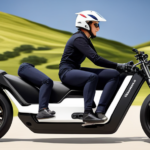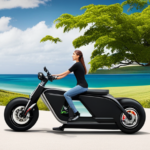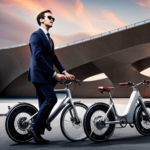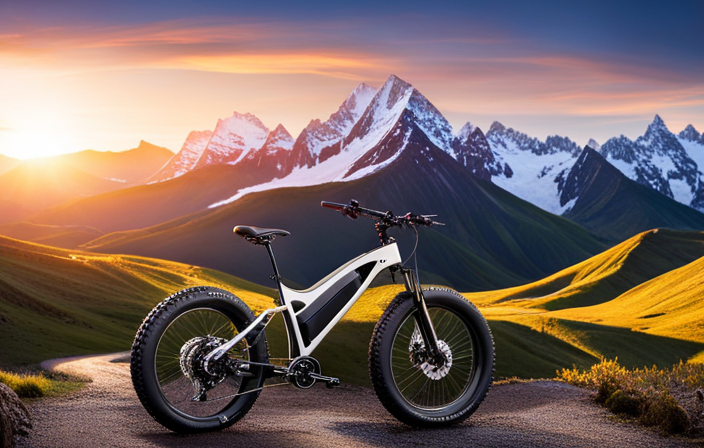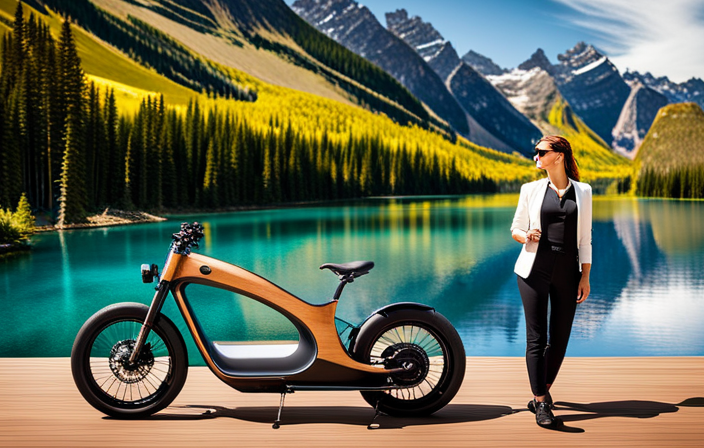Are you ready to experience the exhilarating freedom of going the distance on your electric bike? Imagine soaring effortlessly through winding trails, covering miles upon miles on a single charge.
In this article, I will guide you through the intricate process of calculating the miles you can travel on your electric bike. By understanding battery capacity, evaluating terrain, factoring in rider weight, and considering various other factors, you’ll be equipped with the knowledge to maximize your range and embark on epic adventures with confidence.
Key Takeaways
- Battery capacity, measured in watt-hours (Wh), determines the range of an electric bike and affects the mileage on a single charge.
- Evaluating the terrain, including uphill terrain, off-road paths, and wind resistance, helps accurately calculate the miles that can be covered on a single charge.
- Factors such as rider weight, riding style, temperature and weather, traffic conditions, and group riding can all impact the distance covered on a single charge.
- Strategies for maximizing range include riding in Eco Mode, optimizing tire pressure, reducing weight and drag, and considering performance upgrades.
Understanding Battery Capacity
To understand the battery capacity of your electric bike, you’ll need to consider how many miles you can ride on a single charge. Evaluating battery life is crucial to determine the range your bike can achieve before needing to recharge.
The battery capacity is typically measured in watt-hours (Wh) and can vary depending on the specific model. It is essential to understand battery charging, as this will directly impact the number of miles you can travel. Charging methods, such as fast charging or slow charging, can affect the overall battery life and the number of miles you can ride.
When evaluating terrain, factors like hills, rough surfaces, and inclines can also impact the range of your electric bike. By understanding battery capacity and evaluating terrain, you can accurately calculate the miles you can ride on a single charge.
Evaluating Terrain
When evaluating terrain for electric bikes, it’s important to consider various factors that can affect the battery capacity and overall performance.
Uphill terrain requires more power and can significantly reduce the miles on a charge.
Off-road paths tend to be more challenging and can lead to increased battery usage.
Additionally, wind resistance can also impact the bike’s efficiency, especially when riding at higher speeds.
Uphill vs. Flat Terrain
While riding an electric bike, the distance you can travel on a single charge may vary depending on whether you are riding on uphill or flat terrain. When cycling uphill, the motor of the electric bike needs to work harder to overcome gravity and maintain a constant speed. This increased effort leads to higher energy consumption and a shorter range on a single charge. On the other hand, riding on flat terrain requires less energy as the motor doesn’t have to overcome any significant inclines. As a result, you can expect to travel a greater distance on a single charge when riding on flat terrain compared to uphill. Understanding the impact of uphill vs. flat terrain on energy consumption is crucial in accurately calculating the miles you can travel on an electric bike. Moving on to the subsequent section about off-road vs. smooth paths, different terrains can also affect the range of an electric bike.
Off-Road vs. Smooth Paths
Off-road and smooth paths have different impacts on the range of an e-bike. When riding off-road, the battery life is significantly affected due to the increased resistance from uneven terrain and obstacles. On the other hand, riding on smooth paths allows for a more efficient use of battery power, resulting in longer distances covered.
Here is a comparison of off-road vs. smooth paths in terms of battery life:
-
Suspension: Off-road trails often require a bike with suspension to absorb shocks and vibrations, which can lead to increased energy consumption.
-
Traction: Off-road surfaces, such as gravel or dirt, can cause the tires to slip, requiring more power to maintain stability.
-
Obstacles: Off-road paths may have roots, rocks, or other obstacles that require frequent speed changes, draining the battery faster.
-
Smoothness: Smooth paths offer less resistance, allowing the e-bike to travel further with the same amount of battery power.
Considering these factors, riding on smooth paths is generally more energy-efficient.
In the next section, we will explore another factor affecting e-bike range: wind resistance.
Wind Resistance
Riding an e-bike in windy conditions can decrease its range. To maximize the range of an electric bike, it is important to reduce wind resistance. Wind resistance is the force exerted by the air against the bike and rider as they move through it. High winds can significantly impact the overall efficiency of the bike, causing it to consume more energy and reducing the distance it can travel on a single charge.
To minimize wind resistance, riders can adopt a more aerodynamic riding position, tuck in their elbows, and lower their head. Additionally, wearing tight-fitting clothing and using accessories like fairings can further reduce drag. By taking these measures, riders can increase their e-bike’s range.
Factoring in rider weight is another important consideration when calculating miles on a charge.
Factoring in Rider Weight
When factoring in rider weight, it’s important to consider how it affects the mileage on an electric bike. Evaluating rider experience is crucial in understanding how different weights may impact the battery life and overall distance that can be covered on a single charge. Adjusting pedal assist levels can help optimize the electric bike’s performance based on the rider’s weight. Here are five key points to keep in mind:
- Rider weight directly affects the amount of power needed to propel the electric bike.
- Heavier riders may experience reduced mileage compared to lighter riders.
- The type and capacity of the battery can also play a role in determining the impact of rider weight.
- Some electric bikes have weight limits specified by the manufacturer.
- Properly maintaining tire pressure can help compensate for the additional weight.
Considering riding style, on the other hand, involves analyzing factors such as speed, acceleration, and braking techniques.
Considering Riding Style
When factoring in rider weight, it’s important to also consider the rider’s riding style. Evaluating your riding habits can help determine how far you can go on a single charge.
Do you prefer a leisurely ride or are you more of a speed demon? Riding at higher speeds or constantly accelerating and decelerating will drain the battery faster.
Adjusting power settings can help optimize your electric bike’s range. For example, using a lower power mode can conserve energy for longer rides, while a higher power mode can provide a boost when needed.
By understanding your riding style and making appropriate adjustments, you can maximize the mileage on your electric bike.
Now, let’s move on to assessing efficiency and how to further extend your bike’s range.
Assessing Efficiency
To maximize the range of your electric bike, it’s important to assess its efficiency. Here are three key factors to consider when evaluating battery life and analyzing power consumption:
-
Battery Capacity: The capacity of your electric bike’s battery determines how much energy it can store. Higher capacity batteries generally provide longer range. Make sure to choose a battery with sufficient capacity for your riding needs.
-
Riding Conditions: Riding on hilly terrain or against strong headwinds can increase power consumption and decrease range. Consider the terrain and weather conditions of your regular routes to estimate how they may affect your mileage.
-
Riding Style: Aggressive acceleration, high speeds, and frequent use of power-assist modes can drain the battery faster. Adopting a more conservative riding style, utilizing lower power-assist levels, and maintaining a consistent speed can help extend your range.
By evaluating battery life and analyzing power consumption, you can make informed decisions to maximize the efficiency of your electric bike.
This will be further discussed in the next section, which focuses on monitoring battery health.
Monitoring Battery Health
To ensure optimal performance, it’s important to regularly monitor the health of your battery on your electric bike. Battery maintenance and charging habits play a crucial role in prolonging the lifespan of your battery and maximizing its range. By keeping a close eye on your battery’s health, you can identify any issues early on and take the necessary steps to address them. Monitoring battery health involves checking the voltage and temperature regularly, as well as keeping track of the number of charge cycles. To help you understand the status of your battery, here is a table that highlights the key parameters to monitor:
| Parameter | Ideal Range |
|---|---|
| Voltage | 48V – 52V |
| Temperature | 20°C – 30°C |
| Charge Cycles | Below 500 |
By following these guidelines, you can ensure that your battery remains in good condition, maximizing the distance you can travel on a single charge. This will be further explored in the next section on using range calculators.
Using Range Calculators
Now that we know how to monitor the health of our electric bike batteries, let’s talk about using range calculators to calculate miles on a charge.
Range calculators are a great tool for evaluating battery performance and comparing different electric bike models. These calculators take into account factors such as battery capacity, motor efficiency, terrain, and rider weight to estimate the range of an electric bike on a single charge.
By inputting these variables, you can get a more accurate understanding of how far you can travel before needing to recharge.
Using range calculators not only helps you plan your rides better but also gives you confidence in the capabilities of your electric bike. It’s fascinating to see how different variables can impact the range, and it allows you to make informed decisions when choosing an electric bike model.
Now, let’s move on to the next section and discuss the importance of keeping a record of past rides.
Keeping a Record of Past Rides
Keeping track of your previous rides can be beneficial for monitoring your electric bike’s performance. One way to do this is by keeping a ride log, where you record important details such as distance traveled, battery usage, and any observations about the ride.
This log can help you track your electric bike’s battery performance over time, allowing you to identify any patterns or changes in its efficiency. By regularly updating this log, you can also keep a record of the miles you have covered on a single charge.
This information will be useful when calculating the average miles you can expect to travel on a full battery. Considering external factors such as terrain, weather conditions, and rider weight will further refine these calculations.
Considering External Factors
When considering external factors that can affect the performance of an electric bike, it is important to take into account temperature and weather conditions. Extreme temperatures, such as extreme heat or cold, can impact the battery life and overall efficiency of the bike. Additionally, weather conditions like rain or strong winds can also affect the bike’s performance and handling.
Traffic and stop-and-go riding is another factor to consider. In heavy traffic, frequent acceleration and braking can drain the battery faster, reducing the overall mileage on a single charge. Stop-and-go riding can also have a similar effect, as the constant stopping and starting requires more power from the battery.
Lastly, the choice between riding alone or in a group can also impact the performance of an electric bike. Riding in a group can provide some advantages, such as reduced wind resistance and the ability to draft off other riders. However, riding alone allows for greater control over the bike’s speed and energy consumption.
Temperature and Weather Conditions
Although the temperature and weather conditions can affect the mileage on an electric bike, it is important to consider these factors. The temperature impact on an electric bike’s battery performance is significant. Cold temperatures reduce the battery’s efficiency, causing it to drain faster and resulting in a shorter range. On the other hand, hot temperatures can lead to increased resistance and reduce the battery’s overall lifespan. Weather conditions also play a role in mileage calculation. Riding against strong headwinds requires more power, reducing the bike’s range. Similarly, riding in heavy rain or snow can be challenging due to decreased traction and increased rolling resistance, which can further impact the range. To better understand the relationship between temperature, weather conditions, and electric bike mileage, refer to the table below:
| Temperature Range | Weather Conditions | Impact on Mileage |
|---|---|---|
| Cold (below 32°F) | Heavy rain | Decreased |
| Hot (above 95°F) | Strong headwinds | Reduced |
Considering these factors is crucial for accurately calculating the miles on a charge for an electric bike. Now, let’s move on to the next section about traffic and stop-and-go riding.
Traffic and Stop-and-Go Riding
Traffic and stop-and-go riding can have a significant impact on the overall range of an electric bike. When you encounter traffic congestion or find yourself in a situation where you have to constantly start and stop, it can drain the battery faster than when riding at a steady pace.
Here are four ways in which traffic and stop-and-go riding can affect your electric bike’s battery life:
-
Increased energy consumption: Constant acceleration and braking require more power, depleting the battery more quickly.
-
Reduced efficiency: The frequent stops and starts prevent the bike from reaching its optimal efficiency level, resulting in a shorter range.
-
Longer charging times: With increased energy consumption, you will need to charge the battery more frequently, leading to longer charging times.
-
Decreased battery lifespan: The strain caused by traffic and stop-and-go riding can accelerate battery degradation over time.
Now, let’s delve into the next section about riding alone vs. group riding.
Riding Alone vs. Group Riding
Joining a group for a ride can enhance your overall biking experience and increase your enjoyment. When it comes to electric bikes, riding in a group has its own set of advantages.
First and foremost, it allows you to learn and practice proper riding etiquette. Group riding teaches you how to ride safely in close proximity to others, which is especially important in traffic situations.
Additionally, riding with others can provide a sense of camaraderie and motivation, pushing you to improve your skills and reach new milestones. There’s also the benefit of sharing knowledge and tips with fellow riders, helping you to maximize your electric bike’s range.
Speaking of range, let’s explore how you can get the most out of your bike’s battery power in the next section.
Maximizing Range
When it comes to maximizing the range of my electric bike, there are several key points that I always keep in mind.
First, I make sure to ride in Eco Mode, which helps to conserve battery power and extend my overall range.
Additionally, optimizing tire pressure is crucial for reducing rolling resistance and increasing efficiency.
Lastly, minimizing weight and drag by removing any unnecessary accessories or equipment ensures that I can go the extra mile on a single charge.
By implementing these strategies, I can confidently tackle longer distances without worrying about running out of power.
Ride in Eco Mode
To calculate the miles on a charge for an electric bike in Eco mode, you can use a combination of factors such as battery capacity and energy consumption. Evaluating battery life is essential in determining the range you can expect from your electric bike.
A higher capacity battery will generally provide a longer distance on a single charge. Additionally, choosing the right gear can help maximize your range. Riding in a lower gear allows for more efficient power transfer, reducing energy consumption and increasing the number of miles you can travel.
It’s important to note that riding in Eco mode can significantly extend your battery life, as it limits the amount of power used. By optimizing tire pressure, you can further enhance your electric bike’s efficiency and range.
Optimize Tire Pressure
Optimizing tire pressure can enhance the efficiency and range of your e-bike. By finding the optimal tire pressure, you can reduce rolling resistance and maximize battery life.
When the tire pressure is too low, the contact area between the tire and the road increases, resulting in higher rolling resistance. On the other hand, if the tire pressure is too high, it can lead to a harsh ride and less traction.
To optimize tire pressure, refer to the manufacturer’s recommendations, which are usually indicated on the sidewall of the tire. It’s important to regularly check and adjust the tire pressure to ensure it stays within the recommended range. By doing so, you can improve your e-bike’s efficiency and range.
Moving on to the next section, it’s also crucial to minimize weight and drag to further enhance the performance of your e-bike.
Minimize Weight and Drag
Now that we’ve optimized the tire pressure, let’s move on to the next step in maximizing the miles on a charge for an electric bike: minimizing weight and drag. This is crucial in reducing power consumption and increasing efficiency.
To achieve this, streamlining the bike design is essential. Here are some key strategies to consider:
- Use lightweight materials for the frame and components.
- Minimize the number of accessories and attachments on the bike.
- Opt for aerodynamic shapes and designs to reduce drag.
- Ensure proper bike fit to reduce wind resistance.
By implementing these measures, we can significantly improve the range of our electric bike. Remember, every ounce of weight reduction and every reduction in drag can make a noticeable difference in the overall performance and efficiency of the bike.
Frequently Asked Questions
What is the average lifespan of an electric bike battery?
The average lifespan of an electric bike battery depends on various factors such as usage, charging habits, and quality of the battery. Generally, an electric bike battery can last anywhere from 2 to 7 years, with proper maintenance and care.
Can I charge my electric bike battery while it is still partially full?
Yes, you can charge your electric bike battery while it is still partially full. However, it’s important to note that frequent partial charging can have a negative impact on the overall lifespan of the battery.
Will riding an electric bike on hilly terrain significantly decrease its range?
Riding an electric bike on hilly terrain can indeed decrease its range due to increased power demand. However, efficient riding techniques such as using lower assist levels, maintaining optimal tire pressure, and proper battery maintenance can help mitigate this issue.
How can I estimate the range of my electric bike if I plan to carry a heavy backpack?
To estimate the range of an electric bike with a heavy load, consider factors such as the weight of the backpack, terrain, speed, and battery capacity. These variables can be analyzed to determine the potential distance you can travel.
Do electric bike batteries lose capacity over time, and if so, how can I maintain their performance?
To maintain the performance of an electric bike battery and prevent capacity loss, regular maintenance is crucial. This includes properly charging and storing the battery, avoiding extreme temperatures, and using the battery regularly to keep it active and healthy.
Conclusion
In conclusion, calculating the miles on a charge for an electric bike requires careful consideration of various factors. Understanding battery capacity, evaluating terrain, factoring in rider weight, considering riding style, and assessing efficiency are all key elements.
Additionally, using range calculators and keeping a record of past rides can provide valuable insights. It’s important to also consider external factors and take steps to maximize range.
By following these steps, electric bike riders can confidently plan their journeys and enjoy the thrill of the open road.


